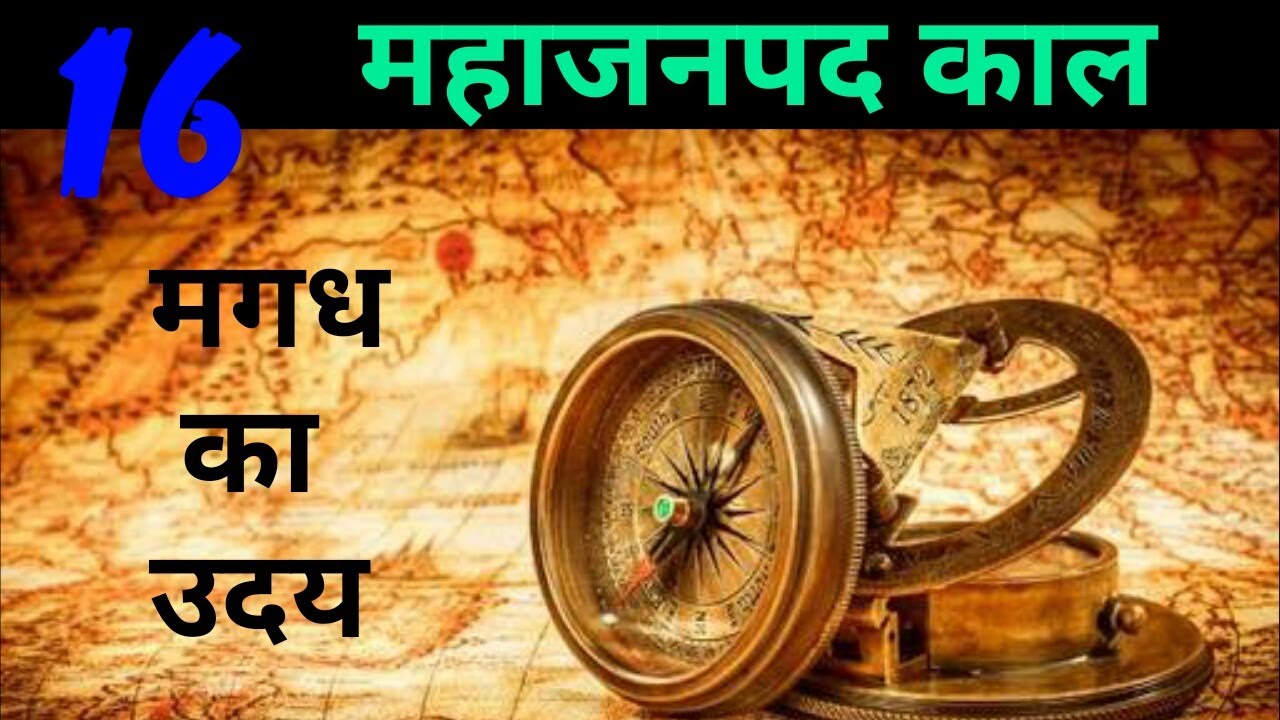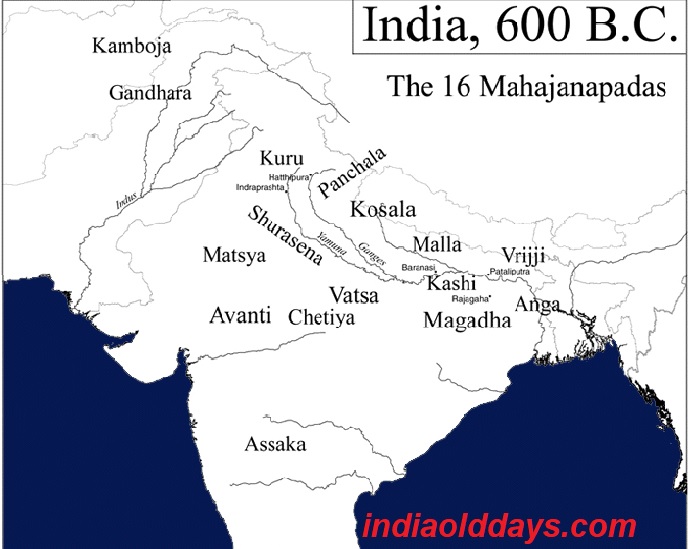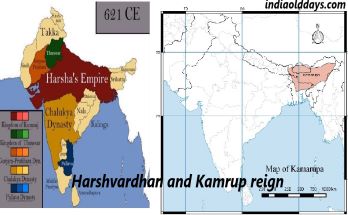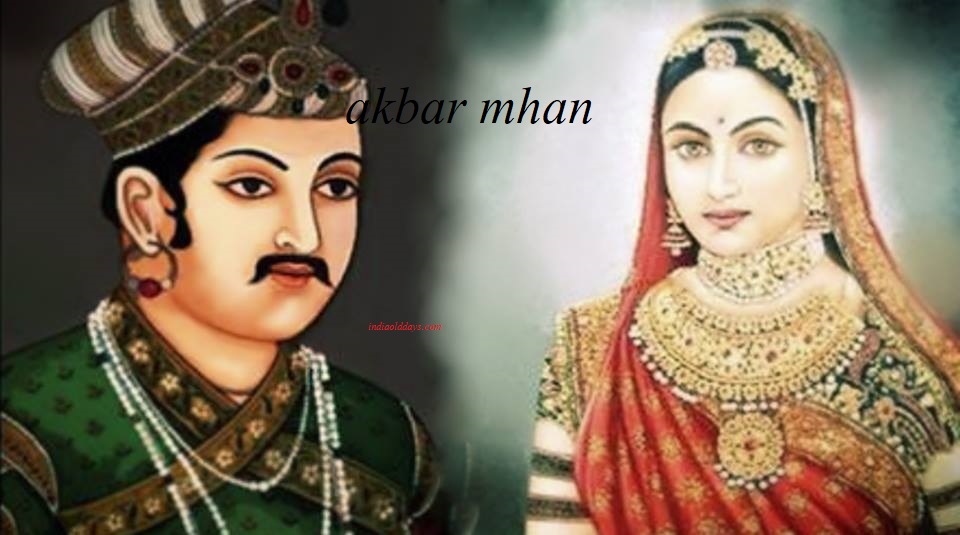16 What were Mahajanapadas
Other Important Facts-
The Mahajanapadas were called to state or administrative units in ancient India. In Uttar Vaidik period, some districts are mentioned. These have been mentioned many times in Buddhist texts as well.
The Mahajanapadas are also known by many other names such as the beginning of formula / Buddha era / second civilization.
16 Mahajanapadas. 15 Mahajanapadas are situated in the north of Narmada. 16th Mahajanapad Ashkk / Ashmak is situated on the bank of Godavari river. Second urbanization started due to Mahajanapadas.
The Anguttr Nikay, Mahavastu (Buddhist texts), Bhagwati Sutra (Jain texts), both of these texts refer to 16 Mahajanapadas.
There is mention of Gandhara and Kamboj in the Anguttr Nikay.
In Mahavastu, the Mahajanapadas – Sibi, Darshan, have been mentioned.
Buddhist texts The answer to the first and certified 16 Mahajanapadas is found in the Angutar Nikay.
16 Mahajanapadas-
-
Kashi–
Kashi was the capital of Varanasi. It has also been called Banaras. The ruler of Varanasi was Ashwaseen (father of Pashwarnath – 23rd Tirthankar). This area was famous for trade of cotton yarn and horse trading. Kosala Mahajanapadas won it.
According to Dasaratha-Jatak, the oldest book related to Ramkatha, Dasaratha, Ram was related to Kashi.
-
Kosala-
Kosala had two capitals. Shravasti and Kushavati Here the famous ruler Prasenjit, who was contemporary of Buddha. Prasenjit married his sister Kosla Devi from Bimbisar and gave him Kashi in Dow. Koshi’s income was given in one lakh gold coins. (Currency system started) and land revenue estimation started in the currency. Prasenjit’s daughter, Vajira was married to Ajatashatru. Another famous ruler of the Kausal Mahajanapadas has been vidudhana.
-
ang- (eastern Bihar)
Champa of the ang’s Capital (it is called Malini in the Puranas). Champa’s architect was Mahagovind. The ruler of the ang was Brahmadatta, who defeated the bimbisar Won.
-
vats
The capital of vats was the Kosambi. King Nichshu of Kuru Dynasty made Koshambi the capital. Further, the rule of the Province of Poverty was established here.
-
Mal-
There were two capitals of Mahajanapada named Mal –Pava and Kushinara (Buddha died in Kushinara). It was the Republic.
-
Vajji-
Vajji literally means- the veterinary group (community) was a republic.
There were 8 groups in Vajji-
- Licchavis –Vaishali,
- Gyatrik the Kundagrama,
- Mithila – Videh,
- Ramgram – Kauliy,
- ugr,
- bhog,
- Morwy,
- Ikshvaku.
Ajatashatru attacked when Mahatma Buddha was present in Vaishali. After a long struggle, Ajatashtru won the split and Vajji groups in the Vajji clans with the help of ministers (Sunidha and varsakara).
-
Sureshn (Mathura) –
Ruler of Sursen ruler Yduvansh According to mythology Awantiputr (Buddha was the son of the daughter of contemporary, Buddha’s disciples), the ruler of that, which Avanti Chandpradyot.
-
Kuru (Delhi, Haryana) –
Indraprastha was the capital city here. Here the ruler was Udayan. Initially, there was a monarchy that later turned into a republic. In the economics and mythology, this Mahajanapadas have been called rajasabdopajiviha.
-
Chedi (Bundelkhand) –
Here was the capital city Sothivati (Sudipati). The ruler of here is Krishna’s Fufara brother Shishu Pal.
-
Ashmak (MP) –
Ashmak was settled on the bank of river Godavari. Capital city ruler Ptina / dub from you.here Arun Thakshask Arun draws its information from invaded Kalinga (Buddhist texts Chullkling.) Assaka Koawanti was won by.
Panchal (UP) –
Panchal had two capitals-the first / northern capital Ahikshitra, the second / southern capital kampilya . Kosal won the Panchal Mahajanapadas.
-
Kamboj (Pak) –
The capital was Rajpura / Hattak. Here the rulers were sudaksina and chandravardhana. The Iranian rulers (Dellis-I / Darabahu) won the combo.
-
Gandhar (Pak Rawal Pindi Peshawar) –
The capital here was Takshshila. Gandhara other cities they were famous-Pushklawati was Pushcasirin ruler Pushklawati (contemporary of Bimbisara sent Dutmondl Magadha court).
-
matsy (Eastern Rajasthan) –
This Mahajanapada was spread in the area of Alwar, Jaipur, Bharatpur. Avanti won this Mahajanapadas.
-
Avanti-
Avanti had two capitals, Ujjain (northern region) and Mahishmati (southern region). The ruler of this region was Chandpradot (contemporary of Bimbisar, Buddha, Prasenjit).
For medical treatment, Bimbisar sent his Rajvady jeevak living in Chandrapadot’s court.
When the Avanti was brought to Magadha by Magadha ruler Shishupala, then the ruler of Avanti was Avantivradhan.
Vatsa Mahajanapada was also made part of Magadha.
Buddha traveled to many areas for promotion of religion but avanti could not go.
-
Magadha (Bihar) –
The capital of Magadha was Girivraj / Rajgaura. The second capital here was Pataliputra. Pataliputra was founded by Udayan.
In Magadha, many dynasties ruled which are the following:
-
Hirakan dynasty –
this dynasty ruled by several kings-
Bimbisar (544-492 BC) –
According to the Puranas, Magadha’s first ruler – Shishunaag was. But Bimbisar has been considered as the first ruler of Magadha in history.
Bimbisar planned to expand political power through marital relations.
The governor of Gandhara of Bimbisar (Pushkrasin), had a political connection with the ruler of Avanti (Chandapradote).
Bimbisar started Magadha imperialism. He first defeated Brahmadatta and mixed the limbs into Magadha.
Bimbisar got the title of “SHRENIK “, “kshetreey bimbisar”.
Buddhism provided protection. Gave the Buddha to Beluwan Vihar donation.
Jainism also considers Bimbisara as the guardian of Jainism.
422 BC In his son Ajatshatru killed Bimbisar (Jain texts do not consider Ajtashatru guilty of patriotism)
Ajatashatru (492-460 BC) –
Ajatshatru maintained the policy of empire expansion. It won the Wajji Union with the help of the ministers, Vesarkar ministers.
It attacked the Kosala ruler Prasnjeet and married his daughter Vajira and recovered Kashi, later, Ajatashtru defeated the Prasenjit and defeated all the rulers after that and conquered the entire Kausal.
Ajatshatru holds the title of Kunik Against Wajjingh, they used warriors like Mahasilalakkak, Rathmusal.
This ruler is a religiously liberal ruler (both Buddhists and Jains regard it as their guardian, but more evidence relates to Buddhism).
At the time of Ajatshatru, the first Buddhist music was held in the Rajghat (Sapta Parnigupa).
Ajatashatru has been shown worshiping Buddha on Vedika of Bharuch Stupa.
Ajatashatru built a stupa on the remains of Mahatma Buddha in the Rajghat.
Udayan-
It established Pataliputra (Kusumpur) and made it the capital. Udayan Jain was a charitable person.
Nadshakak (the last ruler of the Haryanak dynasty) –
Removing this from the public, Magadha governor of Varanasi was made the new ruler, Shishu Pal. And Shishpal established Nagavsh.
-
Nagavansh-
Many kings of Nagasan ruled the Magadha Mahajanapada.
Shishunaag-
Shishunaag had won the Avanti. vashali was second capital.
Kalaashok-
Kalashok has been called the Kakvarna in the Puranas. In the time of Kalashok, the second Buddhist councilorganized.
-
Nand Vansh-
Mahapadananda (Ugrasen) had founded the Nandvans. Mahapadmand is considered to be born from Mahanandin and Shudra, and the Nand dynasty was established. It holds the title of the constellation. Mahapadmanand II is called Parashurama.
Mahapadmand was the character of Shudra. In its time the kingdom of Magadha was spreading to the Punjab in the west.
It attacked Kalinga and Jain Tirthankar brought Pataliputra statue of Sheetalnath.
The canal was built in Kalinga. (Kharwel’s Hathigunda record shows)
Mahapadmanand had 8 sons, his 8th son was Ghananand. Greek historians have called Ghananand as the Agrmij/ Jendrimjije.
At the same time, Alexander was attacked on India. Was the ruler of Alexander (Macedonia).
To know the Mahajanapadas, an important place of both archaeological and literary sources is-
Archaeological sources-
- NBPW (Northern Black Powder Stickers)-
- Damaged Coins / Punchmark Coins – 500 B.C. Nearly old coins of the second century Bc Have been received till The ancient currency and currency system prevailing in India started. Early coins of silver were the most damaged, copper and bronze coins were also received.
Incredible coins were made by marking (marking) marks on a piece of metal. Sick coins also contain remnants of symbols such as fish, pang, peacock, sacrificial altar, elephant, conch, ox, geometric figure (circle, quadrilateral, triangle), rabbit.
There was no regular shape of these coins. They are not considered issued by the kings, but have been regarded as belonging to trading groups.
Most hay coins are from eastern UP (Allahabad, Shahpura) and Bihar (Magadha).
- Kharvel’s elephant cave record – (1st century BC)
Literary sources –
I. Country Literature II. Foreign Literature
I. Country literature –
- Buddhism – Suttapitak, Vinaypitak, Angutar Bodies, Mahavastu
- Jainism – Bhagwati Sutra, Kalp Sutra, Aurashyan, Autobiographical Formula, Agam, Essential Chawni
- Brahmin – Vedanga (education, grammar, astrology, Nirukta, kalpa, verses), mythology.
II. Foreign Literature –
- Herodotus-historica
- Geography of heciticus
- Description of nyarkus
- Details of Uncertainties – Biography of Alexander
- Casey’s Details
All the scholars listed above were contemporaries of all scholars Sikandar.
Details of Plutarch, Justin, Curtius. All these scholars had come after Sikandar, but they also gave details about Sikandar.
Reference : https://www.indiaolddays.com/






